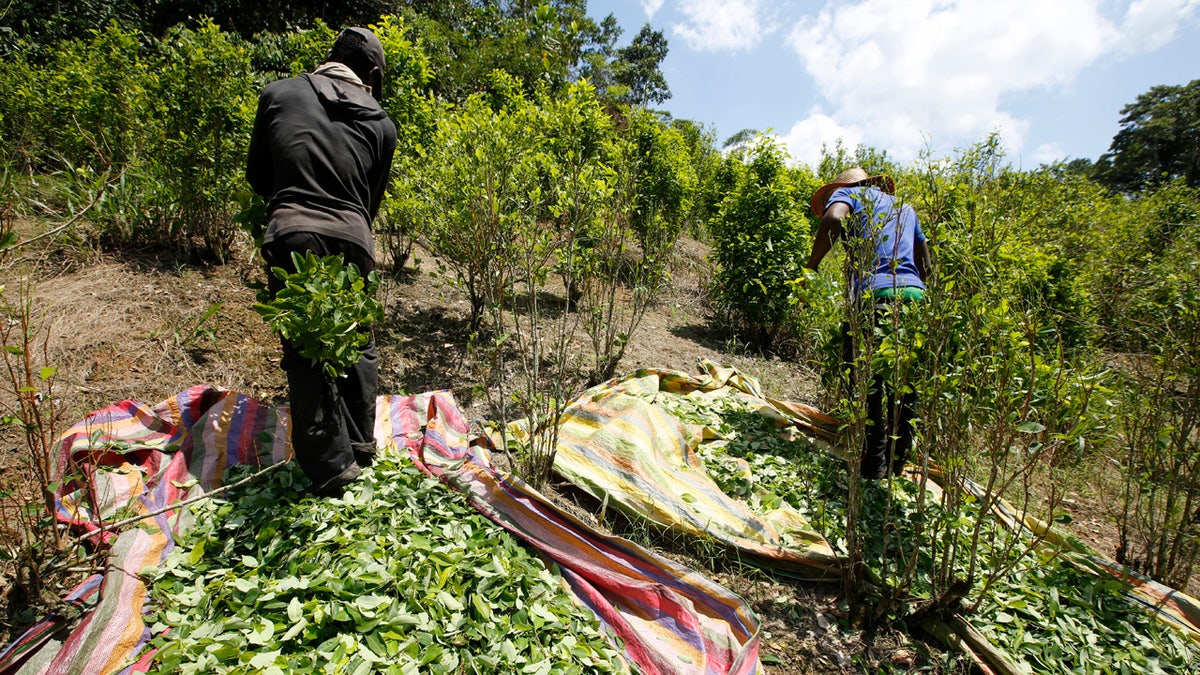
In this March 3, 2017 photo, workers harvest coca leaves in Puerto Bello, in the southern Colombia's state of Putumayo. (AP Photo/Fernando Vergara)
PUERTO BELLO, Colombia – Coca production in Colombia has surged to levels unseen in two decades of U.S. eradication efforts, according to a White House report released Tuesday.
Cultivation of the plant used to make cocaine rose 18 percent last year from 2015, with officials in the Andean nation estimating 188,000 hectares (465,000 acres) of Colombian land now contained coca crops.
The skyrocketing coca production comes as Colombia begins implementing a peace accord that calls on the country's biggest rebel movement to renounce drug trafficking and work with the government to replace coca plants with alternative crops.
But U.S. officials contend the agreement has also provided a perverse incentive for farmers to grow coca, knowing they would later be awarded subsidies if they agreed to renounce coca and grow products like potatoes and fruit instead. Cocaine production began increasing in 2013 and has steadily risen every year since, in part also due to a decision to end aerial fumigations in 2014 over health concerns.
"We have been fumigating these illegal fields for 20 years and we have not achieved great results," said Rafael Pardo, the Colombian government's top post-conflict strategist.
Related stories...
When the U.S.-backed anti-narcotics initiative Plan Colombia began in 1999, Colombia had 123,000 hectares of coca — about one-third less than it did last year. Those figures rose to a high of 170,000 acres in 2001 and then began to decline. The biggest percentage increase over the last two decades took place in 2015, when coca production rose nearly 42 percent. But at no point since at least 1994 has coca production been this high.
U.S. President Donald Trump has proposed to slash foreign aid by 37 percent, a cut that the U.S. State Department's top counter-narcotics official, William Brownfield, called "a bit worrying" in an interview with a Colombian newspaper last week.
Colombian government officials and leaders in the Revolutionary Armed Forces of Colombia have been traveling to remote parts of the country seeking to persuade farmers to voluntarily eradicate 100,000 hectares (250,000 acres) currently devoted to coca.
Thus far, 55,000 families in eight departments have signed pledges to stop growing coca, though many experts are skeptical that poor peasants with little faith in government institutions will entirely renounce an illicit crop that provides their livelihoods. Some 82,000 families across Colombia depend on coca for their sustenance, providing an income of about $1,180 per peasant a year.
The country's top officials say curbing drug production will be critical to the peace agreement's success.
"We cannot allow drug trafficking to coexist with peace and reconciliation," said Nestor Humberto Martinez, Colombia's chief prosecutor.
In Putumayo, a department along Colombia's border with Ecuador that is one of the nation's top coca producers, farmers said they would be willing to renounce drug production if the government provided a viable alternative. Peasants here signed a pledge to develop legal crops earlier this year, but many doubt they could support their families on food crops alone.
"We have always been willing to substitute, but the government has promised and deceived us," said Julio Cesar Jaramillo, a farmer whose 3-year-old daughter already knows how to pluck coca leaves from the plant.
In places like Putumayo, the fallout from past eradication efforts conducted under Plan Colombia lingers. Abandoned fields are still visible along roadsides. Palm trees exposed to aerial fumigation have failed to grow new fronds.
Eduardo Espinosa, 49, lives in a small village an hour from the nearest city reachable only on a journey by river and dirt road. Police and military officials have already begun destroying makeshift laboratories that turn the coca leaves into cocaine paste nearby.
"The coca leaf is our sustenance," said Espinosa, whose lab was one of those recently destroyed. "But it has only brought us exhaustion, notoriety and disillusion. That's not good for anyone."
